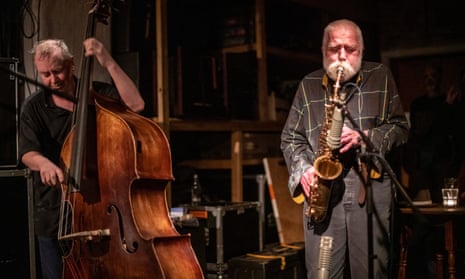The German saxophonist Peter Brötzmann has worked in dozens of different contexts over the years, but his approach usually stays the same. Whether he’s collaborating with Californian noise rockers, Portuguese psych bands, Glaswegian pedal steel guitarists or any number of free-jazz luminaries, you’re likely to hear him play in a big, gruff, fruity honk, making splurges of sound in the mid-range of his tenor saxophone. Tonight’s gig, with his Mental Shake quartet, revealed some unlikely tenderness in the tone of this fearsome avant gardist.
Now aged 81, hunched to the right of the stage, looking like a particularly hirsute Mike Leigh, Brötzmann still plays with an extraordinary energy. He has long been a fan of the vibraphone – he’s cited Lionel Hampton as an unlikely influence on his most famous LP, 1968’s pan-European free-jazz odyssey Machine Gun – and featuring Chicago vibist Jason Adasiewicz in this band reveals hidden depths to Brötzmann’s playing. Adasiewicz sometimes tries to match Brötzmann’s intensity – he hits his instrument hard and percussively, plays dense, chromatic clusters of notes and sometimes plays the role that Bobby Hutcherson performed on Eric Dolphy’s Out To Lunch. But Adasiewicz can also play in a more relaxed four-mallet chordal style, as pioneered by Gary Burton, using lots of pedal and playing sustained, unresolved, modal chords that bring out Brötzmann’s more melodic instincts. In the second half, when Brötzmann switches from alto and soprano to the tenor sax, he responds to Adasiewicz with a series of simple, vibrato-heavy blues riffs, as if playing a collage of random three-note fragments from jazz standards.
These two 40-minute sets ebb and flow in roughly five-minute bursts: Brötzmann might start by freaking out in the higher register while his British drums and bass pairing Steve Noble and John Edwards rumble beneath him, but the players will reduce the intensity, start to ruminate and slowly build up again to another climax. For whole sections you’re amazed that this performance is entirely improvised – it sounds so well structured, so filled with light and shade, so reliant on alert listening, that it could almost have been composed.
